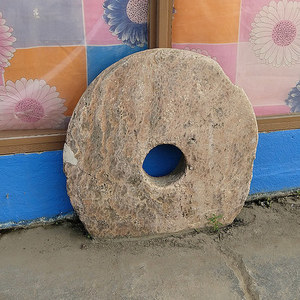This story looks at a small island in the Pacific Ocean called Yap to answer a big question: What is money? On Yap, limestone is considered valuable, much like gold and silver in other places. But because limestone is very heavy, people can’t move it easily. As a result, money has become more abstract. People agree to its value, but don’t necessarily have the limestone itself. Listen to learn what money is and to explore how people in our society, too, buy and sell by using something (coins and bills) that represents something valuable, rather than using the valuable thing itself.
Listen to the story
RENEE MONTAGNE: And there is a tiny island in the middle of the Pacific Ocean that economists love. That’s because it helps answer this really basic question: What is money? Hundreds of years ago, the people on the island came up with an unusual form of money: coins made of stone. That’s not the strange part. Some of the coins were the size of cars. Here are David Kestenbaum and Jacob Goldstein of NPR’s Planet Money.
DAVID KESTENBAUM: The island is called Yap. And if you look it up on a map, it’s just this tiny dot floating in the middle of the Pacific.
JACOB GOLDSTEIN: Scott Fitzpatrick has been to this little dot. He’s an anthropologist at North Carolina State University.
Professor SCOTT FITZPATRICK (Anthropology, North Carolina State University): You know, once or twice a week, they’ve got flights that pass through there. I mean, even today, it’s sort of hard to get there.
KESTENBAUM: When European explorers got there, one thing stood out: huge stone discs – around the village, outside people’s homes.
PROF. FITZPATRICK: If you scrub them, they’re really beautiful, just kind of this milky, crystalline white, and I’ve seen a few of these. If they’re, you know, really cleaned well and they’re out in the sun, they’ll almost blind you, they’re so bright.
GOLDSTEIN: These stone discs, this was their money. Yap doesn’t have any gold or silver. But hundreds of years ago, explorers from Yap found limestone caves on an island hundreds of miles away.
KESTENBAUM: And they carved this limestone into huge stone discs. Somehow they managed to bring them back on little bamboo boats. When the boats got better, they brought bigger stones.
PROF. FITZPATRICK: You have a number of pieces of stone money that have been found at sites that were abandoned. That are, you know, three, three and half meters across that would have been seven, eight metric tons. So that’s about size of two small cars. So it was pretty big.
GOLDSTEIN: It’s unclear if these stones started as money. But at some point, we don’t know when, the people on Yap realized what almost all societies realize. They needed something to store value. They needed something that everyone in the society agreed you can use to pay for stuff.
KESTENBAUM: And like many societies, the people of Yap took the thing they had that was pretty – their version of gold – and they decided that was going to be money.
GOLDSTEIN: Now, a piece of stone money was really valuable. You wouldn’t use it for some everyday purchase. You’d use it for something big like, say, a dowry.
PROF. FITZPATRICK: If somebody was in real dire straits and they were, you know, something happened to their crop of food or they were running low on provisions, and they had some stone money, they might trade. And some people have argued that stone money itself is probably modeled on money that was seen elsewhere.
KESTENBAUM: Just bigger.
PROF. FITZPATRICK: Yeah, way bigger weighing and very ungainly to move.
KESTENBAUM: So you’ve got money but it weighs as much as a car, which makes it pretty cumbersome.
GOLDSTEIN: And that’s why this very concrete form of money quickly makes the jump to becoming something very abstract.
PROF. FITZPATRICK: They often talk about the stone themselves not changing hands at all. In fact, most of the time they wouldn’t – just sheer amount of labor it would take to do it.
GOLDSTEIN: So, okay. Imagine I own this great big stone disc sitting in the middle of our village. David, I want to use it to pay you, but I don’t actually give it to you. It’s just one day, everybody knows it belongs to me. The next day, everybody knows it belongs to you.
KESTENBAUM: And things get even more abstract than that. There’s a story about one time, a crew of workers is bringing a big piece of stone money back to Yap on a boat. And just before they get back to the island, they run into this huge storm and the stone ends up on the bottom of the ocean.
GOLDSTEIN: But the workers, they make it back to Yap and they tell everybody what happened. And everybody says, okay, no problem – that piece of stone money, it’s still good, even though it’s on the bottom on of the ocean.
PROF. FITZPATRICK: So somebody today owns this piece of stone money, even though nobody ever seen – you know, nobody has seen it for over 100 years or more.
KESTENBAUM: Doesn’t that seem kind of amazing to you though. Yeah. Yeah, it was a huge one. It was giant and more beautiful than anything. But unfortunately I don’t have it here. Man, that is the definition of abstract money.
(Soundbite of laughter)
PROF. FITZPATRICK: Yeah, it really is, isn’t it?
KESTENBAUM: So when I first heard this story it seemed funny to me. But then I realized, oh, I use stone money all the time.
Jacob, if I write you a check, what’s really changing in the world?
GOLDSTEIN: I mean I guess there’s like some digits in your bank account that are sort of in my bank account now. But basically, that stone on the bottom of the ocean that you used to own, now it belongs to me.
KESTENBAUM: On Yap today, stone money is still important. But mostly they use something not quite as heavy. They use the dollar.
I’m David Kestenbaum.
 © 2011 National Public Radio, Inc. Used with the permission of NPR. All rights reserved.
© 2011 National Public Radio, Inc. Used with the permission of NPR. All rights reserved. Vocabulary
- money – something that’s used as a medium of exchange, a unit of accounting, and a store of value
- dowry – property or money a bride brings to her husband when they marry
- dire straits – a condition of extreme distress; a bad situation
- provisions – a stock of needed supplies
- abstract – expressing a quality apart from an object
Listening Comprehension Questions
- Why is limestone considered valuable on Yap?
- What does it mean to say that limestone “quickly made the jump to being something very abstract”?
- What is an example of the abstract nature of limestone-as-money?
- How is the exchange of limestone like today’s exchange of money in many countries?
Discussion Themes
- According to the story, what is money? What characteristics does it have?
- Do you agree with the story that the story of limestone on Yap “in the end, feels really familiar”? Why or why not?
Teacher’s Guide
Activate student knowledge: Open class by asking students how they and their families buy things. Do they use bills and coins? Do they use debit cards? Credit cards? Explain to students that however they pay for things, they are using something that represents value. A five-dollar bill is only valuable because we all agree that it is worth five dollars. A debit card pays for a box of cereal because we all agree that the card is somehow taking money from a person’s bank account and putting it into a store’s bank account.
Introduce the story: In this audio story, you will hear about the unusual economy on the island of Yap and learn about what makes money money.
Active listening supports: Choose one of the following listening organizers to support student understanding as they listen to the story.
- The T-Chart Questions and Answers will guide students’ listening by posing questions that help them focus on key points in the story.
- The Language Identification organizer allows students to follow along and track important phrases while listening to the story.
Reflect on the story: Take time for student reflection on the audio story and discussion questions to check for understanding. Ask students how the story of limestone on Yap helps them understand the money they use. What, if anything, makes the Yap example easier to understand than their own society’s money?
Paired Text: Use Section 4 of this article from the Federal Reserve Bank of Atlanta to pair with this audio story. It offers a different perspective on the stone discs on Yap. Have students compare and contrast the different points of view about Yap in this piece and in the audio story.


